Protests such as those in the pictures below differ in many respects. Some are large while others tend to be small. They target different levels of government and make different types of demands and they differ in their means as well, some (partly) violent, some not. The recent protests in France about pensions reform saw more than a million people on the streets asking for a specific change of a law. The 2011 “Arab spring” protests in Tunisia were also massive and eventually targeted the overthrow of the political regime. Service delivery protests in South Africa in contrast tend to feature a few dozen local citizens, and seek to render local politicians more responsive.

© ymphotos/shutterstock.com

© ImageArc/shutterstock.com
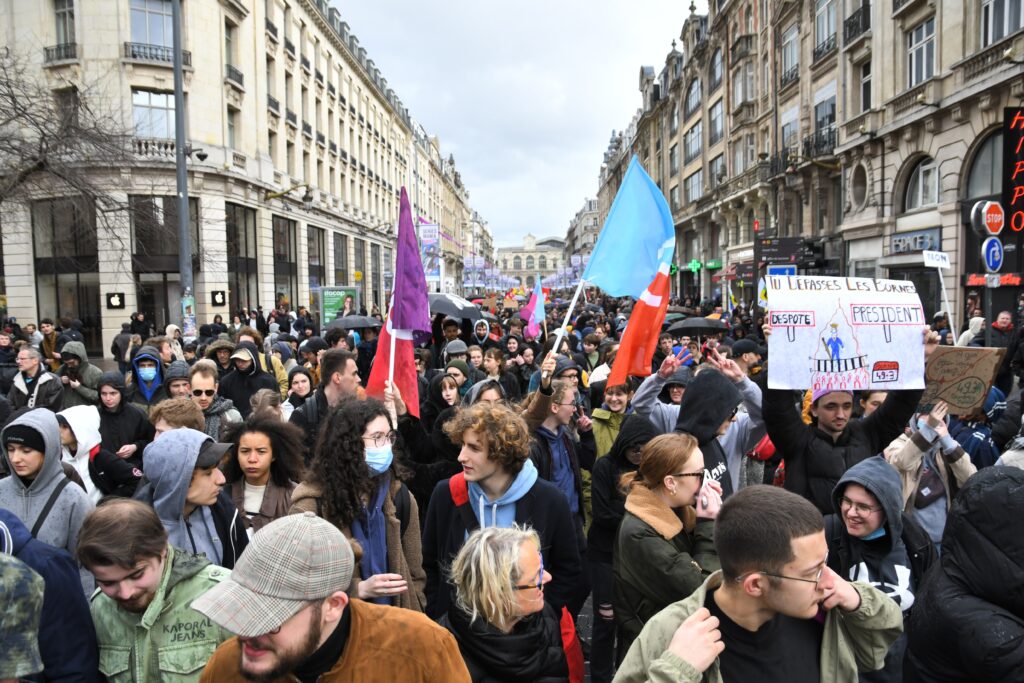
© pmvfoto/shutterstock.com
And yet, with all these differences, all these protests have two important things in common. they convey information about preferences of citizens and pressure the state for change. From the perspective of inequality and distributive politics, this immediately brings the question of who protests and why: whose grievances are we hearing about? Who is putting pressure on the state and who is not?
The intuitive answer is that citizens protest when they have strong grievances. This seems reassuring because it would imply that policymakers and society at large get to know the strongest grievances and pressure is made to address these grievances.
However, as made clear already by social movement scholars from the 1970s, grievances are not enough. To engage in protests, citizens also need to feel they can effect change, what is known as efficacy. Efficacy is a combination of several things (Van Zomeren et al. 2008, Agostini and Van Zomeren 2021): an assessment of the costs and benefits of mobilization (do you have resources to connect to people with similar grievances? Do you have the skills to conceptualize your grievances into specific protest demands?), your psychological disposition to believe that you can affect the world around you, the belief that you belong to a group that can make things happen, etc.
So who protests then? Those with the most grievances or those with more efficacy? Who do policymakers and society hear? And in particular, are the most disadvantaged in the society heard? Disadvantaged citizens have a priori more grievances, but they may also display lower efficacy: they may have less connectivity and less skills to mobilize; they may have more tendency to feel depressed and hopeless and thereby have a lower sense of being able to change things. So, are the grievances of the most disadvantaged articulated?
We can answer these questions with data from the World Values Survey/ European Values Survey, a survey that has collected data from the 1980s in more than 100 countries in all regions of the world. It has information on protest and on different dimensions of disadvantage, such as education, gender, and class background, so we can check who tends to protest more: advantaged or disadvantaged citizens.
Overwhelmingly it is the more advantaged that participate in protests more. The graphs here show how much advantaged citizens protest relative to disadvantaged in each country-year in the data. If both protested equally as much, the dots would be over the diagonal 45-degree line (the red line). But almost all dots are above that line, which means that advantaged citizens tend to protest more. This is the case almost always and everywhere: there are very few points that lie underneath the red line.
Remarkably, the more advantaged participate more, regardless of the dimension of disadvantage we consider. In terms of education: people with tertiary education protest more than those with less than tertiary; men protest more than women; and citizens born to a high class (as measured by the education of the father), also protest more than those of lower class.
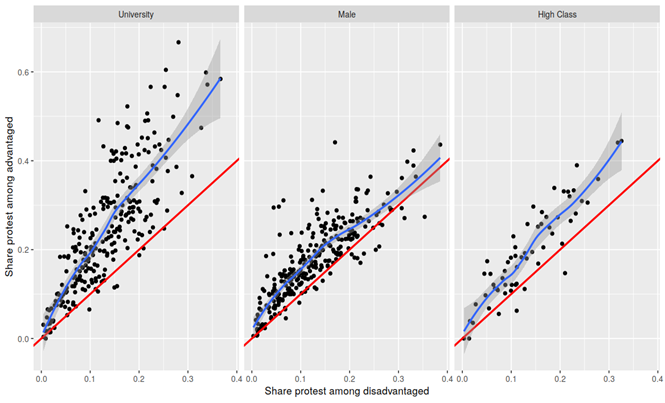
So it seems that overall, protests are driven more by efficacy than by grievances, and so the most serious grievances, those of disadvantged citizens, might remain unarticulated after all.
This seems like a sensible conclusion because it seems sensible to assume that more advantaged citizens have fewer grievances. However, there is a context where this may not be the case: the case of education in the Middle East and North Africa (MENA).I the MENA, unemployment rates are very high among college graduates, and there are strong concerns about the challenges that young graduates have in starting young adulthood. It could be that the higher rates of protest among graduates in the MENA reflect their higher level of grievances.
In fact, a prominent explanation of the root causes of the Arab Revolutions of the early 2010s is precisely this: the reduction in returns to education that have taking place in the region over the last decades led to grievances by the youth that fueled the protests that swept the region. And arguably the dominant narrative about labor markets problems in the MENA is precisely about this: that university graduates lack opportunities.
In our research on Policies, and on Inequality and Collective Action, we have studied whether we can understand the over-representation of highly educated citizens in MENA protests as driven by their particularly strong grievances.
First, in this paper, I have studied whether returns to education really decreased over time in Tunisia, the cradle of the “Arab Spring”. Returns to education are difficult to estimate because people with high education differ in many respects from those with low education (for example, they tend to come from better families). So if we find workers with high education earn much more this may not reflect the effect of education as such, but rather the advantage from being born in a better socioeconomic environment. And the same applies to changes over time. Maybe the differences in wages between high and low education workers have decreased, but if this is due to the fact that now family background matters less, that would actually be a cause for celebration, rather than of grievances.
To address this difficulty, I follow a long literature and estimate returns to education using education policy changes. In Tunisia, successive governments after independence have sought to regulate educational attainment by changing the promotion rate to secondary school (see left-side graph below). In the early 1970s, as education had been increasing dramatically after independence leading to capacity problems, the promotion rate was decreased dramatically. Thereafter in the 1980s and 1990s, as the amount of jobless youth without education rose, authorities sought to keep youth in school longer, and promotion rates were increased. It is remarkable that one can observe the consequences of these changes for the educational attainment of Tunisians nowadays. The right-side graph shows current educational attainment of Tunisian born in different years. The lower educational attainment of cohorts affected by the reduction in promotion rates of the 1970s is striking.
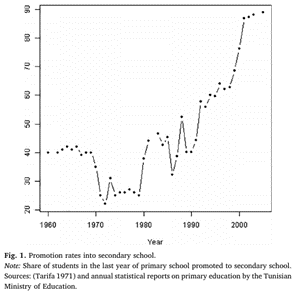
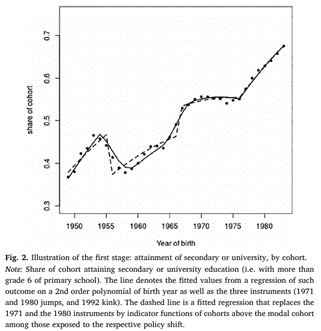
This is useful to estimate returns to education because we can compare cohorts born in nearby years where one cohort got exposed to one of these reforms and the other did not (for instance, compare those born around 1953 and those born in 1957). These cohorts should be relatively similar, except that one ended up with lower education because of the reform. So if they differ in wages, we can be fairly certain that the differences are due to education and not to other things.
What is fairly unique in this case is that we can exploit not just one reform, but three reforms that affected different cohorts. And in this way, we can see if returns to education changed over time: if the benefits of education have indeed decreased substantially for younger cohorts. If so, that would indeed provide a serious substrate for grievances.
Using this approach, we find that returns to education did fall quite dramatically in Tunisia. For people born in the 1950s, attending school for four more years would have increased the chances of working in the public sector by around 25pp. For those born in the 1970s, the increase is less than half as big: around 10pp.
So it seems that there is good case for youth in the MENA to have felt aggrieved regarding the payoffs of the education investment. However, this does not mean that they are the only ones aggrieved, or that their grievances are the stronger. How about those left without education? Do they generally refrain from protesting because they are more satisfied? Or are they even worse off, but they do not protest because of lack of efficacy?
We took up this question in a paper with Ragui Assaad, Caroline Krafft and Colette Salemi, from the University of Minnesota. We analyzed surveys from Tunisia and Egypt, focused specifically on youth and with questions on political participation.
We found that youth with more education do participate more politically, by voting and for the case of Egypt, having been more likely to participate in the 2011 revolution. However, when considering levels of satisfaction, we found that those with low education are even less satisfied with their lives, less happy, and even possibly less satisfied with their country.
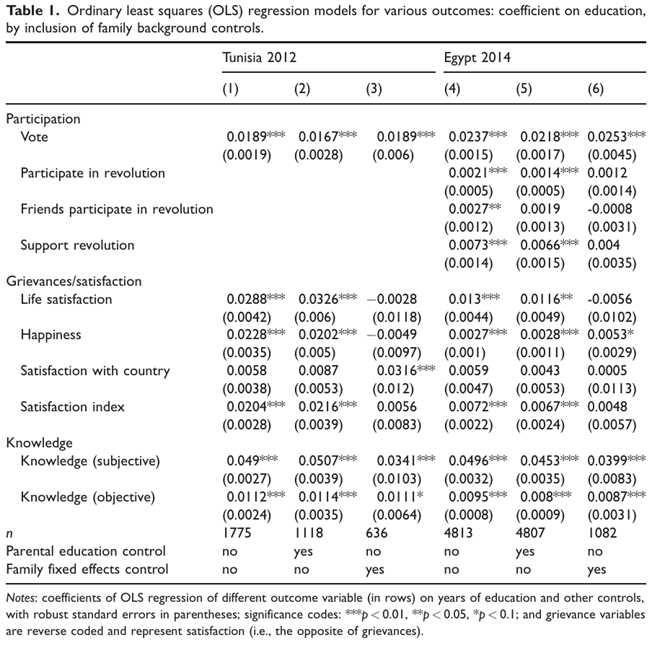
So it does not seem that youth with more education had more grievances. What they did seem to have more, however, was efficacy: They felt confident of knowing more about politics, and when asked objective questions about politics, they indeed knew more.
We can now go back to the question at the beginning: who protests? whose grievances are we hearing? It seems that, overall, we are hearing the grievances of relatively privileged citizens. Of high educated, of men, of people born in higher classes.
Even in contexts where we can identify genuinely serious grievances among those that protest, as is the case for the educated youth in the Arab Revolutions, it is still the case that those that apparently have more grievances (those without education) are less likely to participate. In other words, even when we know that those that participate are relatively disadvantaged, they are still advantaged relative to those that do not participate. The most disadvantaged seem to remain largely unheard.
References
Pellicer, Miquel. 2018. The evolution of returns to education in the Middle East and North Africa: Evidence from comparable education policy changes in Tunisia. Economics of Education Review 62: 183-191.
Pellicer, Miquel, Ragui Assaad, Caroline Krafft, and Colette Salemi. 2022. Grievances or skills? The effect of education on youth political participation in Egypt and Tunisia. International Political Science Review, 43(2), 191-208.
Van Zomeren, Martijn, Tom Postmes, and Russell Spears. 2008. Toward an integrative social identity model of collective action: a quantitative research synthesis of three socio-psychological perspectives. Psychological bulletin 134(4): 504.
Agostini, Maximilian, & Martijn van Zomeren. 2021. Toward a comprehensive and potentially cross-cultural model of why people engage in collective action: A quantitative research synthesis of four motivations and structural constraints. Psychological Bulletin 147(7): 667.
